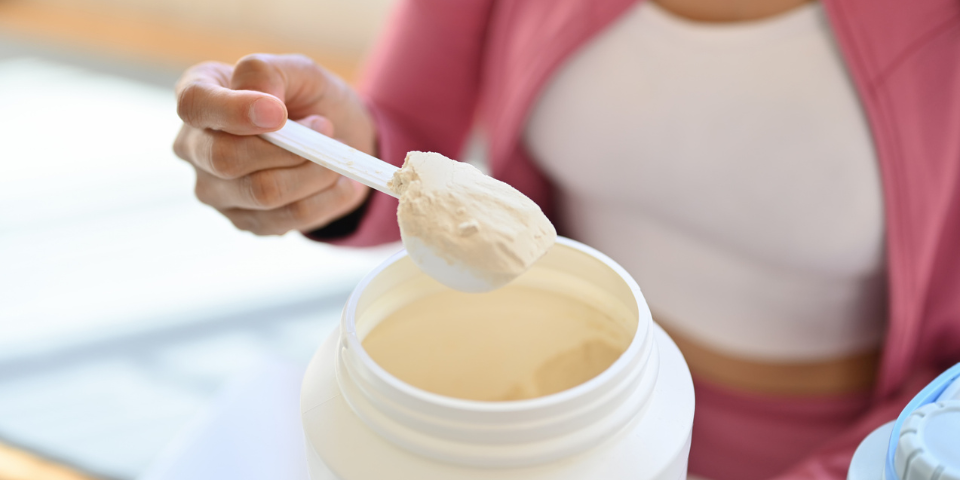You probably know protein is an important part of the muscle-building process. But this macronutrient matters more than you may think. It also plays an essential role in recovery and even bone health.
While the majority of protein should come from whole food sources like beef, chicken, fish, eggs, dairy, and beans, a good protein powder can deliver high-quality protein in a concentrated, more convenient form.
And whey protein is considered the gold standard because it has all of the amino acids your body needs to fuel muscle gain and recovery, making it a “complete” protein.
Understanding that whey is a great option is pretty simple. But before you grab any old whey powder, the details make all the difference in ensuring you’re giving your body what it needs — and not getting ripped off.
Here’s what you need to know about whey protein isolate vs. concentrate — and how each type of whey protein can play a role in an athlete’s diet.
What Is Whey Protein?

Whey is derived from milk and is a byproduct of the cheese-making process: Enzymes are added to milk to separate the liquid from curds. After the curds are drained, the leftover liquid is whey.
This liquid was originally considered a “waste” product. Then supplement makers realized whey could be used as a high-quality, valuable protein.
Because whey production is a multi-step process, there are different variations. Whey protein is primarily offered as two different variations: whey protein concentrate and whey protein isolate.
Knowing the difference (and what to look for on a label) will go a long way to ensuring you get the most out of your protein supplements.
Whey Protein Isolate vs Concentrate: What Are the Differences?
The main difference between whey protein isolate and whey protein concentrate is protein content.
Whey protein concentrate is the most common form of whey protein. To understand how whey protein concentrate is processed, imagine whey falling off a conveyor belt into buckets. All you need to do is filter out impurities, dehydrate it, flavor it, and call it “Delicious Chocolate Whey Concentrate.” (Coming soon to a supplement store near you!) Some supplement companies may do more than that to their concentrate products, but it’s not required.
That means whey protein concentrate can vary widely in terms of protein content. Whey protein may be labeled as “concentrate” if 25 to 89 percent of its content by weight is protein. So if you scoop out 100 grams of protein powder, it can be called whey protein concentrate if anywhere between 25 and 89 grams of that is protein.
Whey protein isolate — found in Beachbody Performance Recover — must be at least 90 percent protein by weight. If you scoop out 100 grams of whey isolate, you will get 90 grams or more of protein — a significant difference compared to concentrate.
Are there any other types of whey protein?
One more type of whey protein you might hear about is whey protein hydrolysate. This type of whey protein has been partially broken down with acid and high heat, making it easier to digest. (For this reason, it’s commonly used in baby formula.)
Hydrolysates are absorbed more quickly than isolates, but there’s no strong evidence to suggest that the faster speed has any added benefit for muscle gain or recovery.
What Are the Benefits of Each Type of Whey Protein?

Most research on protein powders has found that whey protein is the best way to go for muscle growth. Whey protein contains an ideal mix of essential amino acids, and when taken regularly, whey protein can deliver results.
But there are a few unique benefits of each type of whey protein.
Concentrates tend to be the cheapest sources of protein supplementation. This doesn’t mean the product is low-quality, but it does mean it’s not the highest purity for a protein powder.
Whey isolates tend to have a higher price relative to concentrates for four reasons:
- Protein quality. Because it’s a purer form of protein, you get a higher protein-to-calorie ratio.
- Protein purity. Whey protein isolate filters out the rest of the macronutrients, meaning you have less carbohydrates, sugar, and fat.
- Digestion. Whey protein isolate usually has less than one percent lactose, meaning it’s easier on your stomach if you experience lactose intolerance.
- Improved mixability. Whey protein isolate has better solubility, which tends to make it a smoother, better-tasting protein smoothie.
What’s the Best Whey Protein for You?
Both whey protein concentrate and whey protein isolate have important benefits, but whey protein isolate is a purer form of whey protein and has a higher percentage of protein — sometimes much higher — than whey concentrate.
If you buy a concentrate, it’s possible that you’re getting a protein that’s only 25 percent protein by weight.
Whereas if you use whey protein isolate, you’re getting 90 percent protein by weight — so you’ll know you’re getting all the protein and amino acids you need to increase your protein intake and help support your fitness goals.




